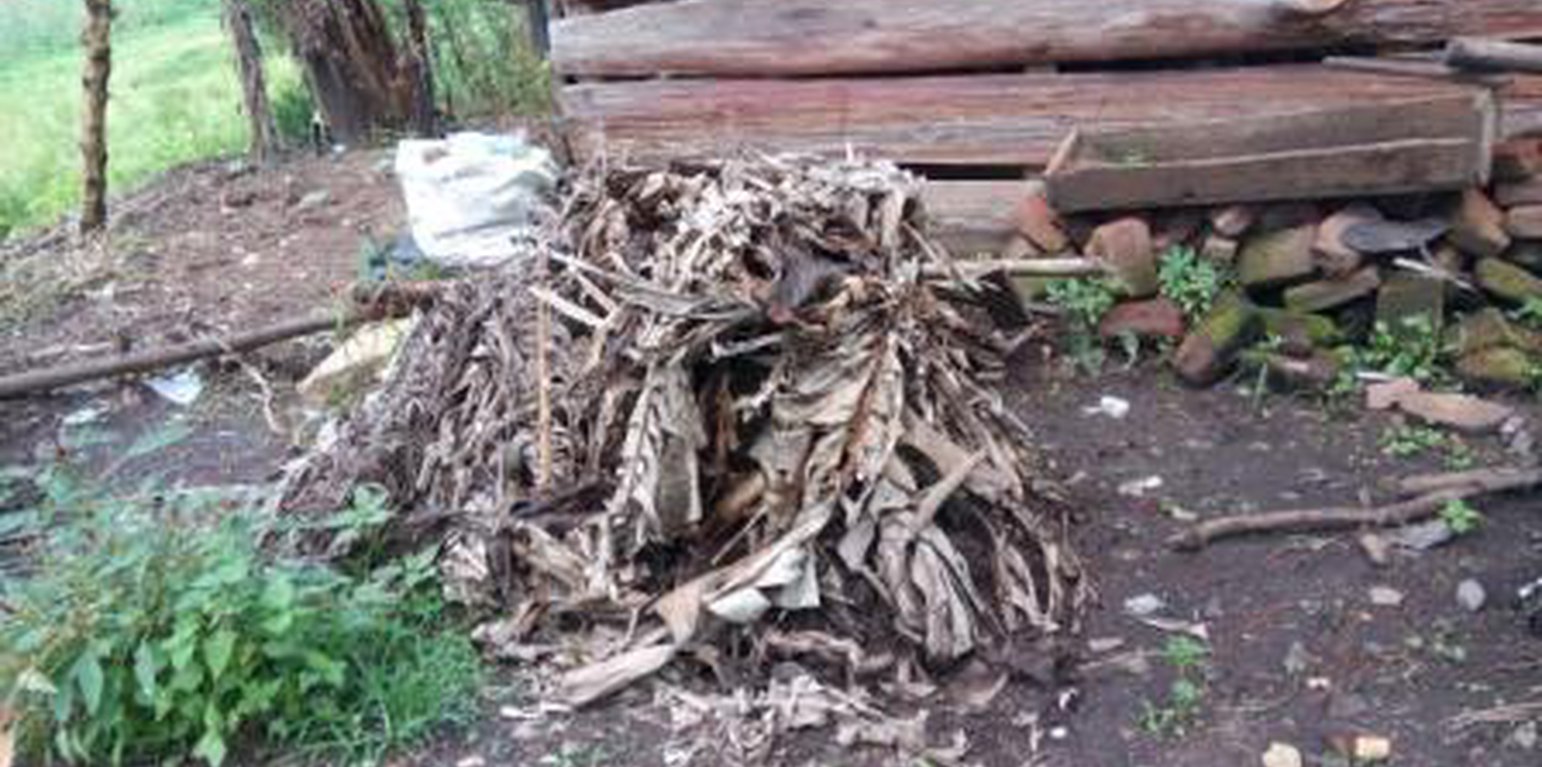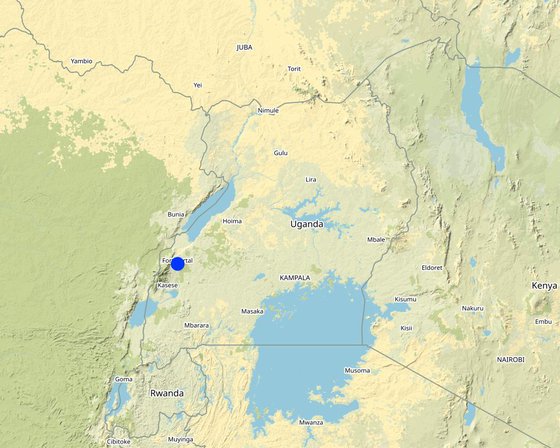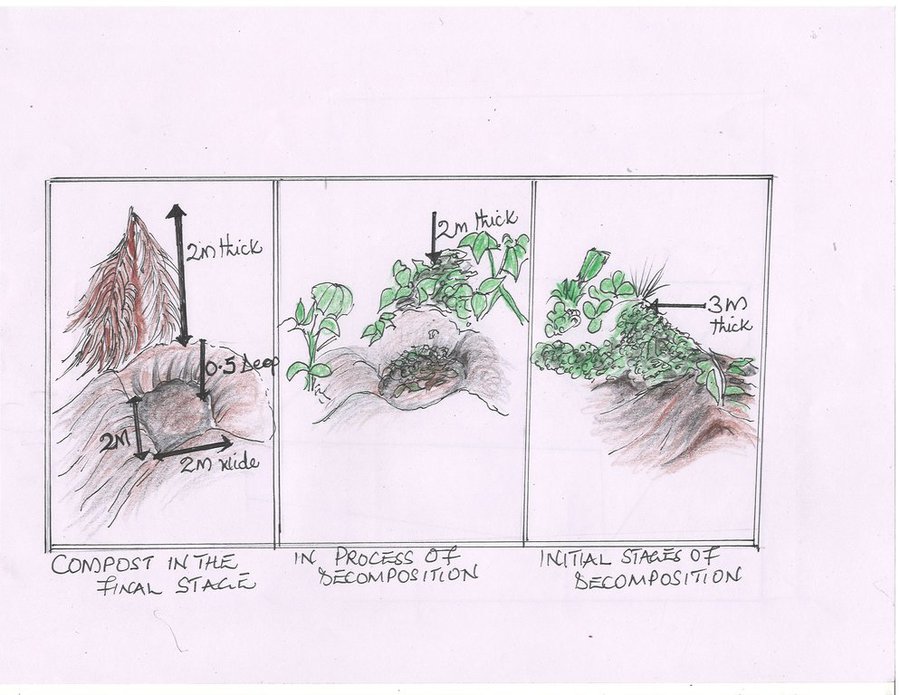



Compost manure application is an integrated pest, disease and soil fertility management technology that cheaply avails organic matter to increase crop/land productivity among local farmers. Farmers use locally available inputs like weeds, kitchen refuse, crop residues (maize, sorghum, millet, wheat among others) at less or no cost. These nutrients are thus made available to plants through transforming raw organic matter into stable humus, which is readily absorbed by plants. This increases agricultural and vegetable production. However, the nitrogen content in the compost can be further increased if waste plant materials such as Lantana Camara, Sesbania are integrated. Procedures to make compost manure include the following steps:
• Digging pits of about 2m length, 2 m width and 0.75 m depth.
• Placing the assorted organic materials in pit no. 1 and covering it with soil in a dome shape to prevent water from seeping into the decomposing materials. Residues so assembled should be in their raw form collected from either the kitchen, weeds from gardens, peelings and crop residues like maize and sugarcane husks. As a rule of thumb, the compost pile should be build by beginning with a bottom layer of bigger sized materials, such as maize stovers, of about 15cm height. This should also include a layer of dry vegetation, hedge or grass cuttings to about 15cm height. Sprinkling top soil and adding water by using a watering can will to moisten the whole layer. In this pit, the degradation process will take a period of 1-2 months.
• In the third month, the materials are then transferred to pit no. 2, arranged and compressed in layers and covered with soil in a dome shaped manner.
• After another spell of 4-5 months, these decomposed materials are then transferred to pit no. 3. This comprises of decomposed matter ready for use. In this last pit, manure in the final stage is always cold, dark and most importantly, less bulky. It produces a pleasant smell when spread.
In case of a banana plantation, ready compost is applied around the banana hills or in trenches between 4 banana plants. Soils with compost cannot easily be washed away by water or blown by wind as the soil particles are held tightly together with the sticky substance secreted in the process of decomposition. This glue-like structure also helps to hold moisture in the soil hence improving the structure.
The farmer selects a suitable and convenient place for the compost pit system preferably near the garden and home stead where he digs three pits. The cost of digging a compost pit depends on where the pits are to be located. If the place is easy to dig, each pit costs about UGX 5,000/=. Other costs include, hiring a spade at UGX 1,000/=, a hoe at UGX 1,000/=, a pan at UGX 1,000/= and a watering can at UGX 1,000/=, all summing up to UGX 9000/= for the whole activity. The technology improves production in both annual and perennial plants such as fodder grasses and crops through restoring degraded soils by improving soil structure, soil moisture and micro organism content. As the technology provides nutrients to plants it also reduces environmental pollution associated with inorganic fertilizer use. Nutrients are released gradually, enabling the following year’s crops to benefit as well. Weeding is done easily in areas applied with compost manure as the soil has a soft texture. Through this technology, home hygiene is improved by utilising wastes. Plant diseases and pests like banana weevils are suppressed.
However, making compost manure is challenging. It requires a lot of commitment and serious efforts to collect the kitchen and garden residues all the time. Digging a pit is quite laborious and farmers with little land find it hard to reserve land for compost pits.
This technology is an agronomic measure that helps in waste management through recycling, re-use or reduction of wastes, thereby improving sustainable land management. Maintenance is always by ensuring that compost pits are not under permanent shade and properly covered. Pits should be emptied after the process is done in preparation for the next cycle.

Localização: FORTPORTAL MUNICIPALITY, KABAROLE, Uganda
Nº de sites de tecnologia analisados: Local único
Difusão da tecnologia: Aplicado em pontos específicos/concentrado numa pequena área
Data da implementação: menos de 10 anos atrás (recentemente)
Tipo de introdução








| Especifique a entrada | Unidade | Quantidade | Custos por unidade (UGX) | Custos totais por entrada (UGX) | % dos custos arcados pelos usuários da terra |
| Mão-de-obra | |||||
| Digging 3 Pits | man pit | 3,0 | 2500,0 | 7500,0 | 100,0 |
| Equipamento | |||||
| Hiring a hoe | pic | 1,0 | 1000,0 | 1000,0 | 100,0 |
| Hiring a spade | pic | 1,0 | 1000,0 | 1000,0 | 100,0 |
| Hiring a watering can | pic | 1,0 | 1000,0 | 1000,0 | 100,0 |
| Hiring a pan | pic | 1,0 | 1000,0 | 1000,0 | 100,0 |
| Custos totais para a implantação da tecnologia | 11'500.0 | ||||
| Especifique a entrada | Unidade | Quantidade | Custos por unidade (UGX) | Custos totais por entrada (UGX) | % dos custos arcados pelos usuários da terra |
| Mão-de-obra | |||||
| Emptying pits | 1,0 | 2500,0 | 2500,0 | 100,0 | |
| Equipamento | |||||
| Hiring a hoe | pic | 1,0 | 1000,0 | 1000,0 | 100,0 |
| Hiring a spade | pic | 1,0 | 1000,0 | 1000,0 | 100,0 |
| Hiring a pan | pic | 1,0 | 1000,0 | 1000,0 | 100,0 |
| Custos totais para a manutenção da tecnologia | 5'500.0 | ||||
Quantidade anterior à GST: 8Kg of bananas in 1 acre
Quantidade posterior à GST: 25kg of banana in 1 acre
Farmers are able with the use of this technology to harvest high yields for both home consumption and commercial purposes.
Moisture increases to 75%
Soils with composts cannot easily be blown by water and wind as the soil particles are held tightly together with the sticky substance secreted in the process. This glue-like structure also helps to hold moisture in the soil hence improving the soil texture and structure and therefore wind and rains cannot blow away the soils.
Nutrients can be recycled in the soil over and over again in the process of applying this manure to the soil.
Breaking down of matter like weeds, shrubs, kitchen residues (banana, cassava, sweet potato peelings) into humus by the micro-organisms improve on the soil organic matter.
High fertility levels of the soils from theses decomposed composts increase the vegetation cover as a result of humus generated.
The quantity of annelids like earth worms increased. This is because they feed on both live and dead organic matter. Earthworms help in the breaking down of organic matter into humus and improve on soil aeration.
Besides enriching the soil with fertility, the compost manure has the ability to suppress diseases and pests in the garden like the banana weevil.